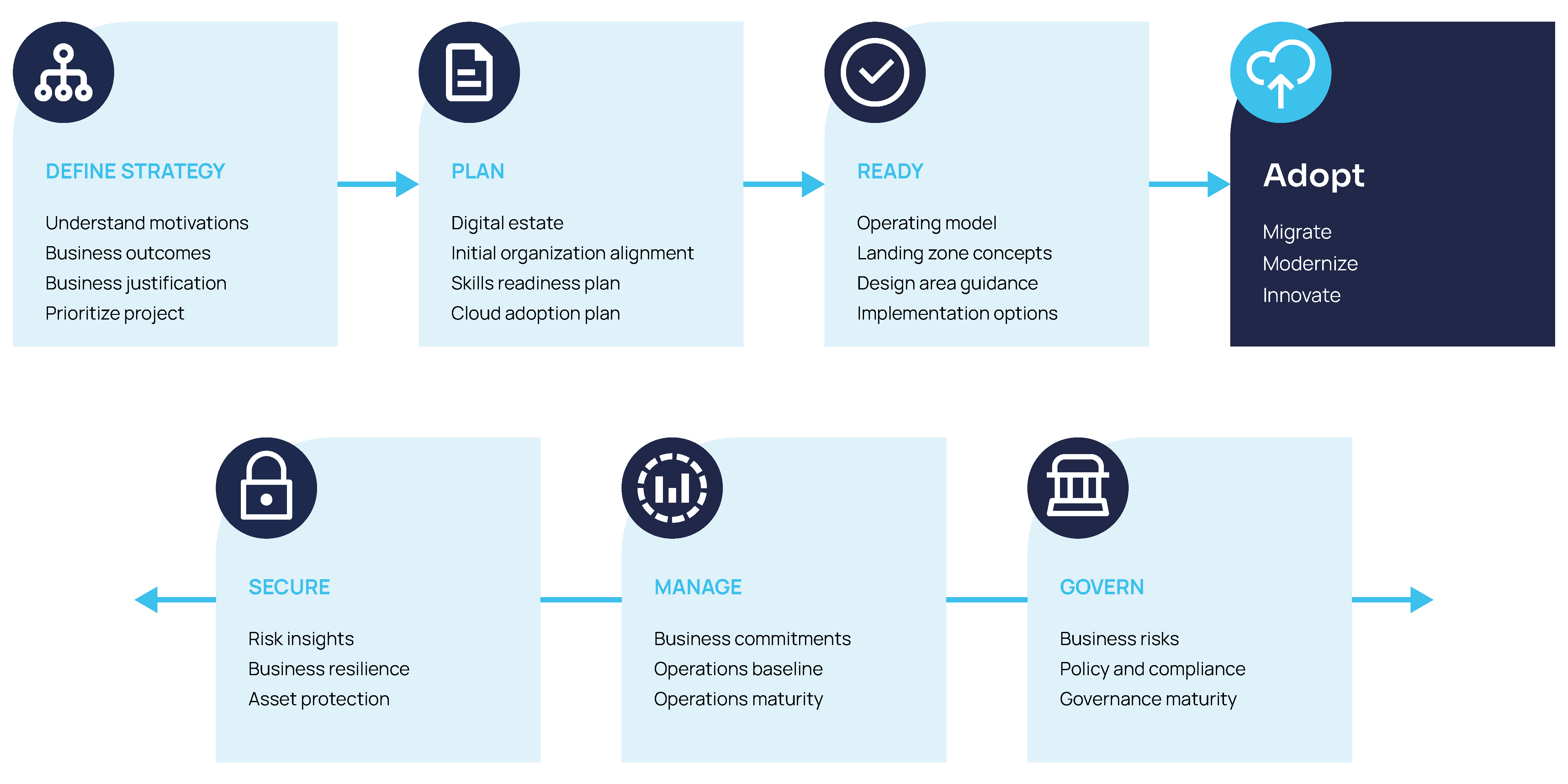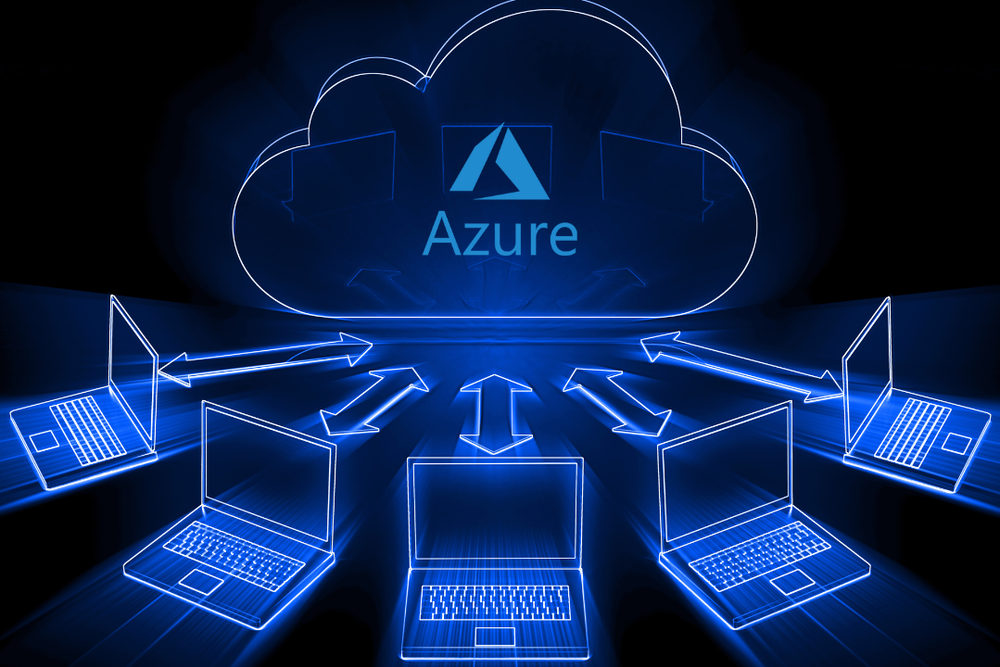In our previous blog posts in the series Successful Migration & Modernization with the Microsoft Cloud Adoption Framework we covered fundamentals, planning and preparation. Now we turn our focus to migrating and modernizing workloads in the cloud. This is the point where concepts and strategies become reality – from the first pilot migration through to optimization in production.
Cloud migration involves both technical and organizational measures. It includes selecting the right migration strategies, using appropriate tools, applying best practices and engaging all relevant stakeholders. The goal is to run applications efficiently, securely and reliably in the cloud. Clear planning, defined responsibilities and a structured approach are essential for a smooth transition.

Microsoft Cloud Adoption Framework
Strategies for Cloud Migration
Depending on application type, business requirements and available resources, migration must be tailored individually. The well-known 6 Rs of Cloud Migration provide a structured framework:
- Rehost (Lift-and-Shift): Applications are moved to the cloud without changes. Fast and cost-efficient, but without architectural optimization. Ideal for legacy systems that need quick relief.
- Replatform: Applications are slightly adapted to leverage cloud services more effectively. For example, migrating an on-premises database to a managed cloud database without rewriting the entire application.
- Refactor: A deep modernization effort, such as breaking up monolithic applications into microservices or container-based architectures. This enhances flexibility, scalability and enables continuous deployment.
- Rebuild: Replace existing software with SaaS solutions. This reduces maintenance overhead and provides immediate cloud functionality.
- Retire: Decommission outdated, unused systems to reduce complexity and costs.
- Retain: Keep certain workloads on-premises for the time being, e.g., due to compliance, regulatory requirements or strong dependencies.
Most organizations apply a combination of these strategies, depending on workload complexity, business priorities and cost efficiency.
Tools & Methods for a Structured Start
Migrating to the cloud requires structured methods to minimize risks and ensure efficiency:
- Azure Migrate: Identifies dependencies, assesses workloads and provides migration recommendations. Particularly useful for analyzing on-premises environments and uncovering interdependencies between servers and applications.
- Pilot Projects / MVPs: Small-scale test migrations uncover potential challenges before critical workloads are moved. This could be a single module or database running as a prototype in the cloud.
- Non-Production Environments: Development, testing and staging environments allow thorough validation. Regression, performance and security testing ensure stability in production.
- Controlled Deployment: Rollback strategies, monitoring and extensive testing ensure safe introduction of changes into production.
Would you like to develop your first cloud applications on Azure in a modern and scalable way? Our team supports you with Azure Native Application Development, from MVPs to greenfield projects.
Modernization Opportunities in the Cloud
Migration is just the starting point – modernization unlocks the long-term benefits of the cloud:
- Containers: Provide portable, scalable deployments and simplify dependency management.
- PaaS (Platform as a Service): Services like Azure App Service, Azure SQL Database or Logic Apps allow teams to focus on applications without managing underlying infrastructure.
- Microservices: Modular architectures improve flexibility, enable continuous deployment and simplify updates.
- Auto-Scaling & Optimization: Cloud-native features like auto-scaling and load balancing help optimize resource usage and reduce costs.
Modernization is not only technical – it drives agility, lowers long-term maintenance costs and prepares applications for future growth.
Success Factors for Sustainable Cloud Adoption
- Continuous Optimization: Tools like Azure Advisor or Azure Monitor provide recommendations on cost, performance, security and reliability. Improvements should be prioritized and implemented systematically.
- Operational Readiness: Ensure monitoring, alerting, backup and disaster recovery are properly configured for all new components. Chaos testing can help validate resilience.
- Feedback & Measurement: User feedback, support tickets and KPIs help identify optimization potential. Results should be documented and shared with stakeholders regularly.
- Automation: Azure Policies, auto-scaling, cost monitoring and security checks ensure consistency and reduce manual effort.
- Documentation & Knowledge Transfer: Playbooks, checklists and lessons learned safeguard long-term operations and ease onboarding for new team members.
The 6 Rs of Cloud Migration

The 6 Rs of Cloud Migration
Conclusion
Migration and modernization are not one-off projects, but ongoing processes. Organizations that systematically migrate, modernize and optimize their workloads gain long-term benefits in flexibility, scalability and cost efficiency. With structured planning, careful testing, targeted modernization, and continuous optimization, companies can build a cloud landscape that is robust and ready for new business opportunities.
Cloud adoption doesn’t end with migration – it truly begins when organizations establish a culture of continuous improvement. This way, your IT remains modern, agile and prepared for future demands.
Start your cloud journey today – whether with personalized migration consulting or building cloud-native applications:
📆 Outlook
With this post, we conclude the first part of our series Successfully Migrating & Modernizing with the Microsoft Cloud Adoption Framework. We have shown how to move from initial considerations to the successful migration and modernization of your workloads in the cloud.
Next, we will focus on the second part: operations, security, and governance in the cloud. Look forward to practical insights on topics such as cloud security, FinOps and establishing the right governance structure – ensuring that your cloud environment not only works but is sustainably and successfully operated.
